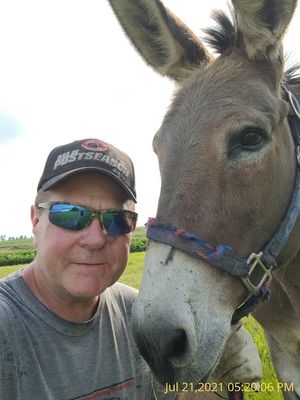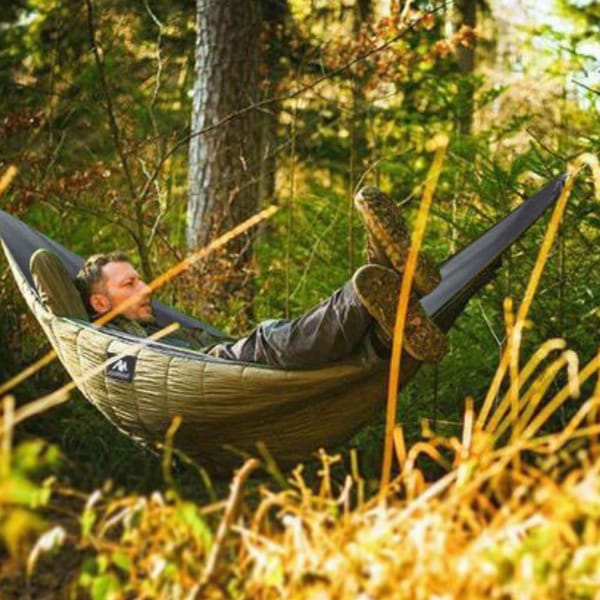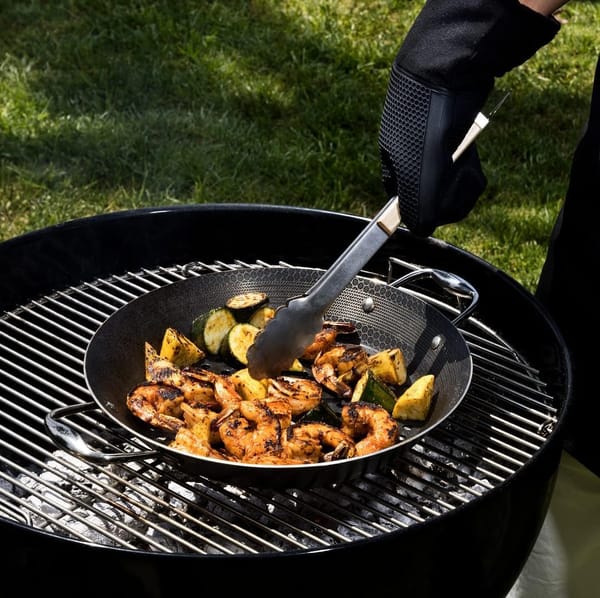Imagine the thrill of camping in the frosty winter wonderland, with snow-capped trees and icy landscapes all around. The only thing standing between you and the biting cold is your trusty insulated tent. With the right insulated tent, you can stay cozy and warm even in the most frigid conditions. So, let’s explore the world of insulated tents and discover how to choose the perfect one for your next chilly adventure!
Key Takeaways
- Stay warm and cozy on your winter camping adventures with the perfect insulated tent!
- Discover fabric or quilted-insulated tents, rooftop tents, and more from top brands like Thule Tepui & Yakima.
- Explore key features of ventilation, waterproofing & durability to find your ideal shelter, plus tips for easy setup and maintenance!
Understanding Insulated Tents
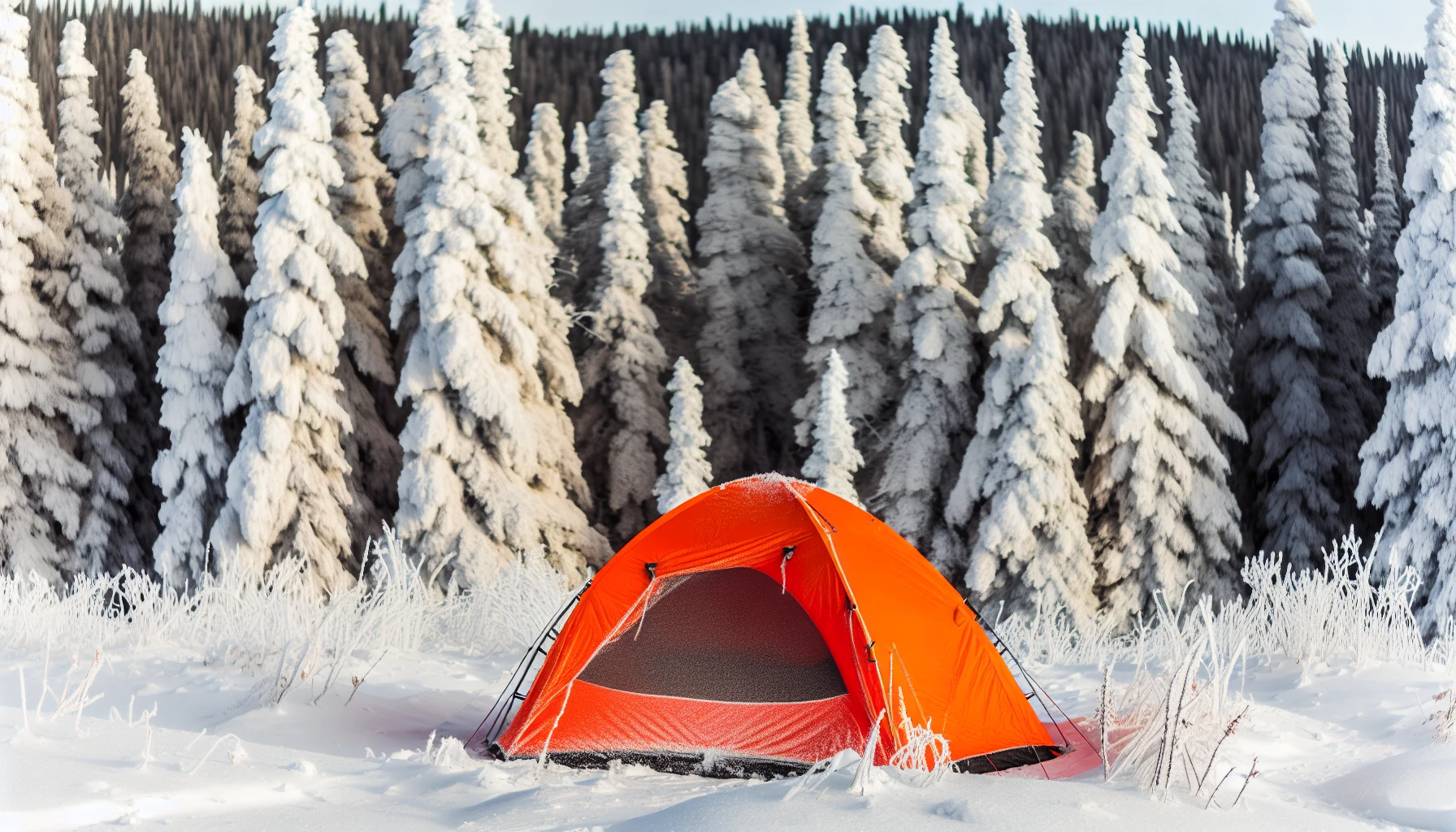
Insulated tents are designed to keep you warm and comfortable in cold weather, even when temperatures fall. There are two main types of insulated tents to consider: fabric-insulated and quilted-insulated, as well as rooftop tents with insulation. Each type has its own advantages and drawbacks, so it’s essential to understand the differences before making your choice.
Embark on a journey to understand insulated tents better and ensure your next winter camping trip is a warm and comfortable success!
Fabric-Insulated vs. Quilted-Insulated Tents
Fabric-insulated tents, known for their lighter weight, compact size, and cost-effectiveness, are an excellent choice for backpacking and mountaineering enthusiasts. They work by incorporating insulating layers, such as foam or air pockets, to create a barrier that reduces heat transfer through conduction, keeping the interior warm and cozy. However, they may not provide the same level of warmth as quilted-insulated tents, which use a combination of materials like ripstop nylon and other insulating fabrics for superior heat retention. Quilted-insulated tents can be more expensive, but they offer a higher level of warmth and coziness, making them a popular choice for those willing to invest in the ultimate winter camping experience.
When it comes to thermal performance, fabric-insulated tents use thermal fabric with insulating properties, while quilted-insulated tents have quilted insulation that’s more effective at limiting heat exchange with the cold outside air. This makes quilted-insulated tents better at retaining heat, ensuring you stay warm and comfortable throughout the night.
Whether planning a chilly backpacking adventure or a luxurious winter getaway, it’s important to understand the differences between fabric-insulated and quilted-insulated tents to choose the ideal shelter.
Rooftop Tents with Insulation
For those seeking an elevated camping experience, rooftop tents with insulation offer a unique and exciting option. These tents are designed to be mounted on top of a vehicle, providing additional warmth and protection from the cold ground. Rooftop tents are generally warmer than ground tents, thanks to their thicker or insulated materials and elevated position away from the cold ground.
Top brands for rooftop tents with insulation include:
- Thule Tepui
- Yakima
- Front Runner
- Freespirit Recreation
- Roofnest
- Crua Outdoors
These brands offer a range of options to suit your needs and budget. So, if you’re looking for an insulated tent with a twist, consider a rooftop tent to enjoy both warmth and panoramic views from the comfort of your car’s roof.
Top 5 Insulated Tents for Various Camping Needs
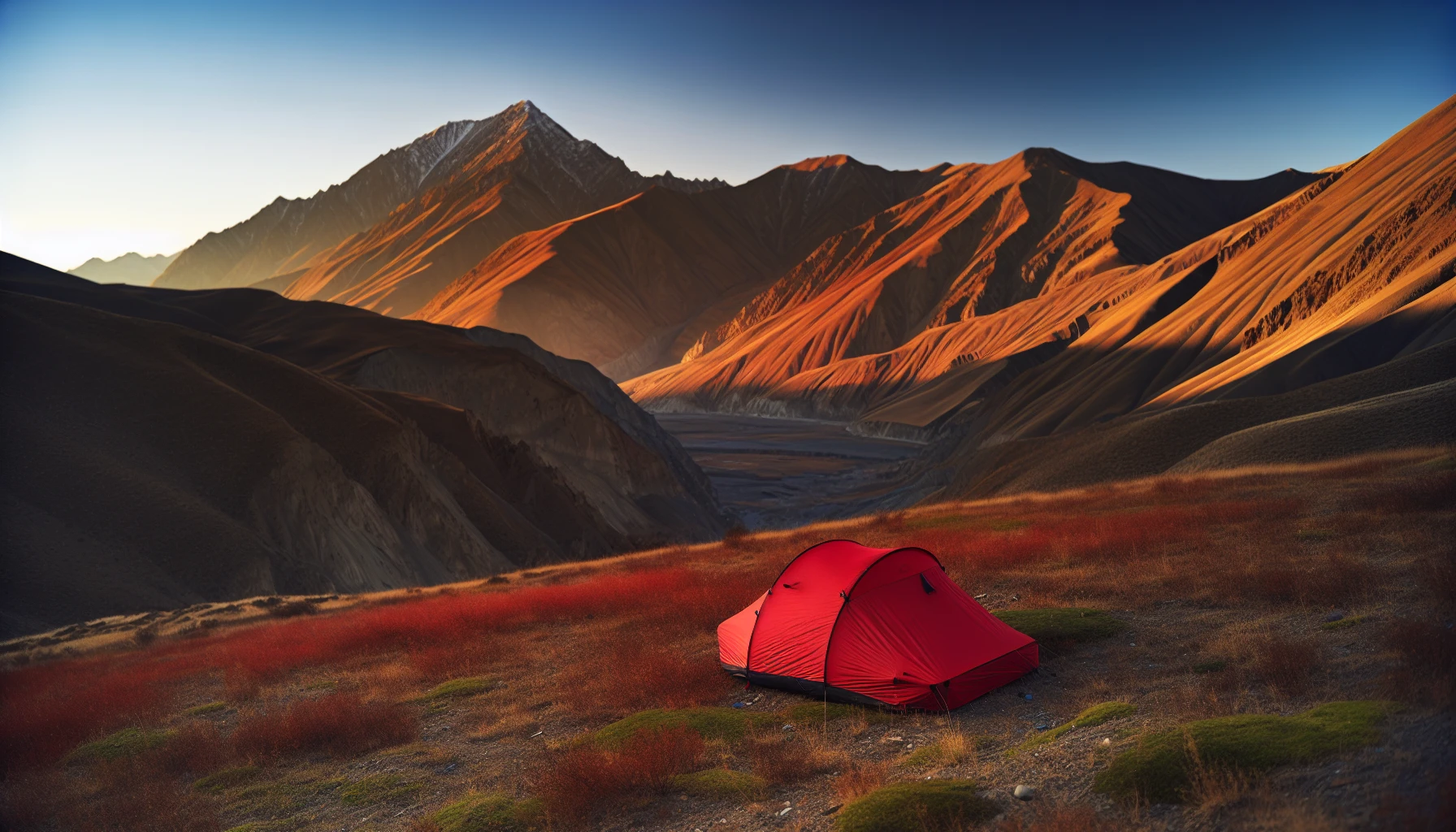
To make your search for the perfect insulated tent easier, we’ve compiled a list of the top 5 insulated tents for various camping needs, including the best overall, budget-friendly, backpacking, mountaineering, and premium options. These tents have been carefully selected based on their insulation properties, durability, and convenience, ensuring you get the best possible shelter for your winter camping adventures.
Let’s examine the details and find the ideal insulated tent for your needs!
Best Overall: Crua Culla Insulated Inner Tent
Claiming the title of the best overall insulated tent is the Crua Culla, featuring quilted insulation and an innovative airframe design. This tent is perfect for cold weather car camping, providing a cozy and comfortable shelter that’s easy to set up and highly efficient at retaining heat. The Crua Culla offers a spacious interior with room for up to three people, making it an excellent choice for families or groups of friends who want to stay warm and cozy during their winter camping trips.
The major downside of the Crua Culla is its price, as it is costlier than some full-featured tents. However, the premium materials and excellent insulation make it a worthwhile investment for those who prioritize warmth and comfort during their winter camping adventures.
With its packed size of 28” x 15” x 15”, the Crua Culla is easy to transport and store, ensuring you’re always ready for a cozy camping trip.
Budget-Friendly Option: REI Co-op Base Camp 4
If you seek a cost-effective insulated tent without compromising on quality, consider the REI Co-op Base Camp 4. This dome-shaped tent features fabric insulation and a sturdy, watertight construction, making it a reliable shelter in various weather conditions.
With double doors for easy access, a large mesh roof for stargazing, and multiple small pockets for storage, the Base Camp 4 offers an excellent balance of comfort and affordability. The 3-season-plus insulation ensures you stay warm and cozy during your camping adventures without breaking the bank.
For Backpacking: Sea To Summit Telos TR2 Plus
Backpackers seeking a lightweight and compact insulated tent will love the Sea To Summit Telos TR2 Plus. This 3+ season tent features a fabric-heavy canopy and excellent ventilation, making it an ideal shelter for backpacking in colder climates. The unique double-vestibule design, “Tension Ridge” brow pole, and double “Apex Vent” design provide additional comfort and convenience while on the trail.
Weighing in at just 3 pounds 10.7 ounces, the Telos TR2 Plus is the perfect balance of insulation, weight, and packed size for backpackers who prioritize warmth and comfort during their adventures.
For Mountaineering: Mountain Hardwear Trango 4
When it comes to mountaineering, durability and weather resistance are paramount, and the Mountain Hardwear Trango 4 delivers on both fronts. This insulated tent is built to withstand extreme conditions, featuring a tough DAC Featherlite frame and a floor fabric rated at an impressive 10,000mm of waterproofing. The Trango 4 is designed for mountaineers who need a reliable and strong shelter in harsh environments, making it the perfect choice for high-altitude adventures.
With a price range of $$$, the Mountain Hardwear Trango 4 offers top-notch performance and durability for those willing to invest in their mountaineering shelter.
Premium Choice: Crua Tri
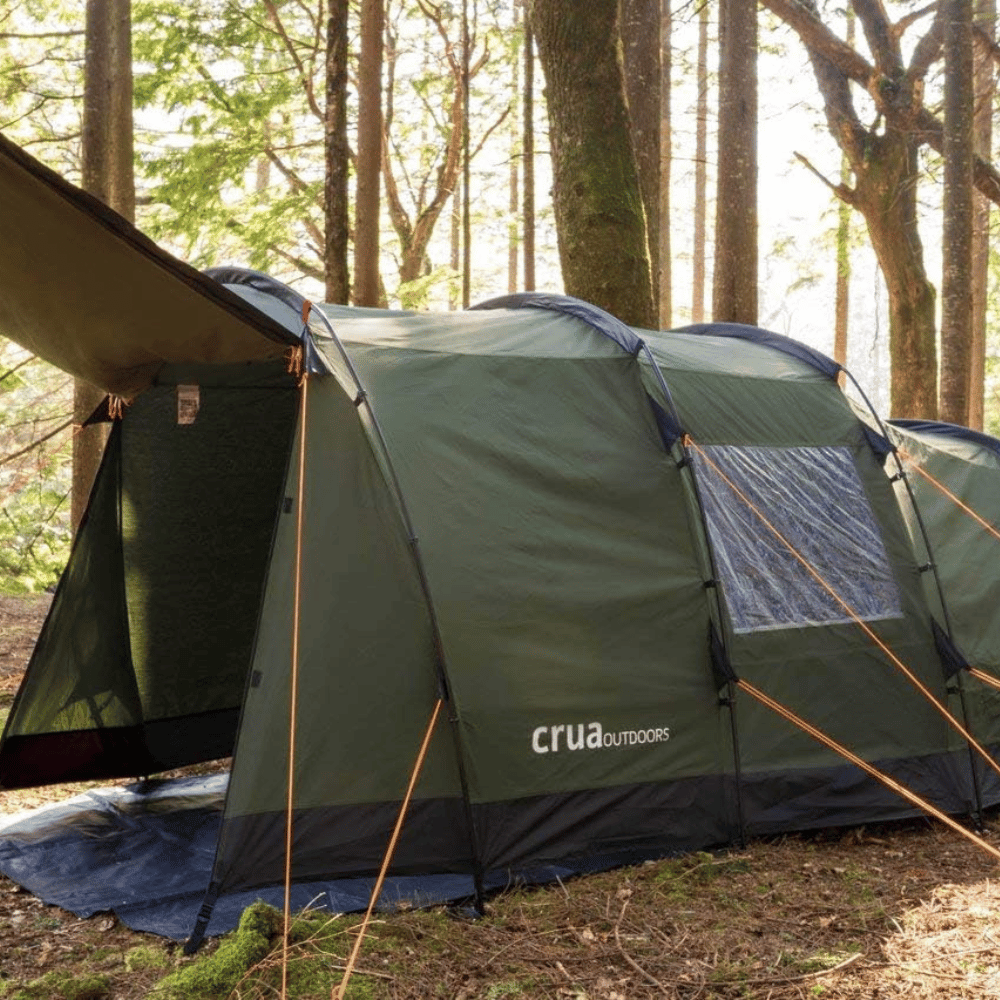
For those seeking a premium insulated tent option, look no further than the Crua Tri. This luxurious 3-person tent boasts:
- Quilted insulation
- High-quality materials
- Warm and cozy even in the coldest weather
- A spacious bedroom that can accommodate up to three people
- 3-foot porch
- Zippered slot under the front door for power access
The Crua Tri offers an indulgent camping experience.
The Crua Tri is an expensive tent and an investment in comfort and warmth, making it the ideal choice for those who want the best of the best in insulated tent options.
Key Features to Look for in an Insulated Tent
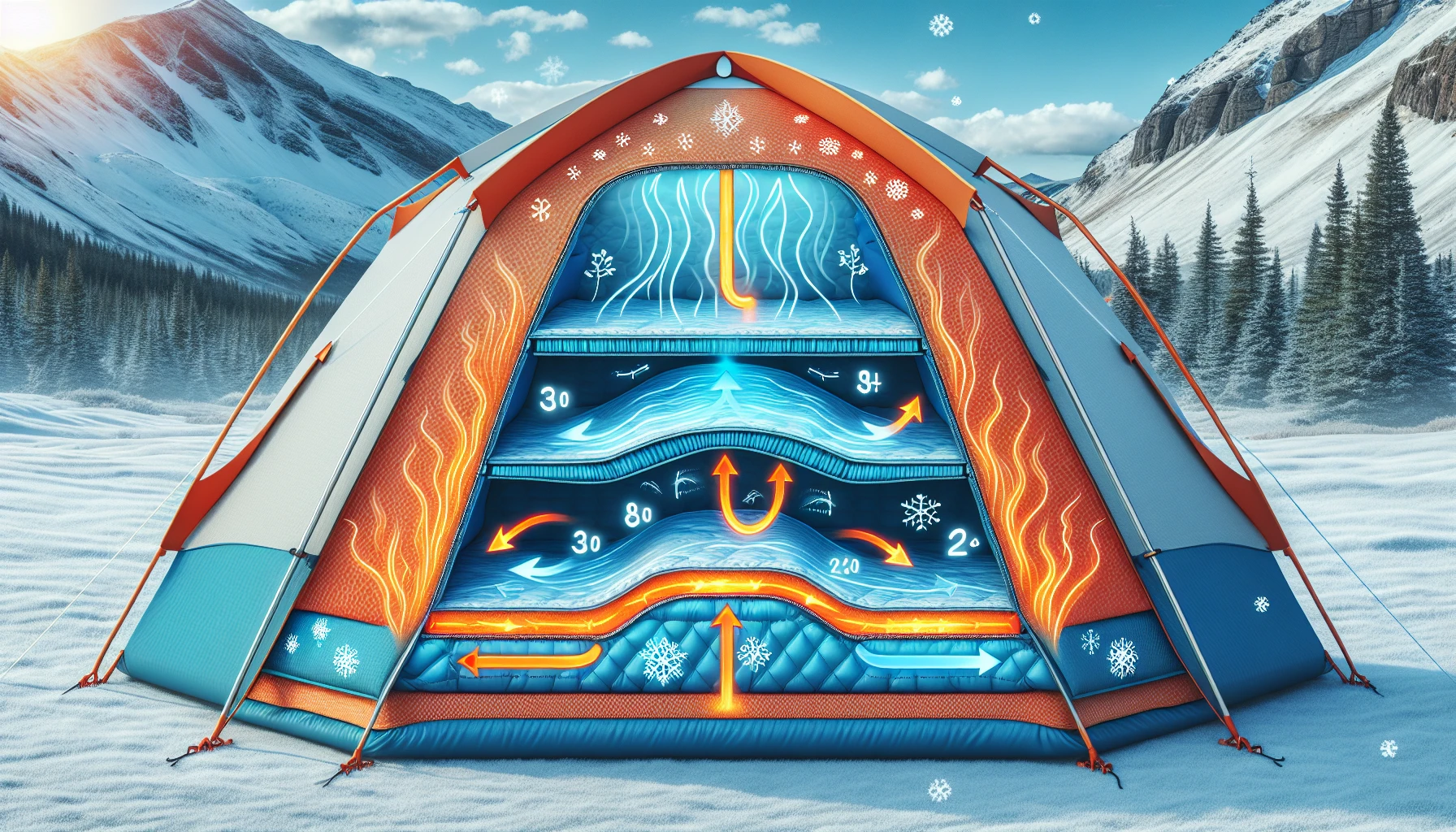
When choosing the perfect insulated tent for your winter camping adventures, it’s essential to consider key features that will ensure your comfort and safety. Ventilation, waterproofing, and durability are all crucial factors to look for when comparing insulated tents.
Proper ventilation can help balance warmth and moisture inside the tent, while waterproofing ensures you stay dry and protected from the elements. Finally, durability is vital in ensuring your tent can withstand the harsh conditions of winter camping.
Let’s explore these important features in more detail to help you find the perfect insulated tent.
Ventilation and Condensation Management
A well-ventilated tent is essential for maintaining a comfortable temperature inside, as proper airflow helps to regulate heat and moisture levels. Adjustable vents and double-wall designs can help achieve this balance, with vents allowing you to fine-tune airflow and double-wall designs providing insulation while also allowing for proper ventilation.
By ensuring your insulated tent has adequate ventilation, you can enjoy a cozy and comfortable camping experience without the risk of condensation buildup and dampness inside the tent.
Waterproofing and Weather Resistance
Waterproofing is a crucial feature of any tent, as it ensures you stay dry and protected from rain, snow, and other wet weather conditions. Tent insulation, exterior vestibules, and high-quality external vents can help to provide additional protection from the elements.
Tents with clean seam taping, water-resistant fabrics, and sizeable exterior vestibules are ideal for keeping you dry and comfortable during your winter camping adventures. Don’t let a leaky tent ruin your camping trip – pay attention to waterproofing features when choosing your insulated tent.
Durability and Material Quality
The durability of your insulated tent depends on the quality of its materials and the strength of its frame. Thick fabric and trusted brand poles, such as DAC Featherlite or carbon fiber composites, are essential for ensuring your tent can withstand the rigors of winter camping.
By investing in a durable insulated tent with high-quality materials, you can enjoy years of cozy winter camping without the worry of your shelter failing you when you need it the most.
Space, Comfort, and Setup Considerations

When choosing the perfect insulated tent, it’s essential to consider factors such as:
- Size: Ensuring you have enough space for occupants and gear while maintaining optimal thermal efficiency
- Interior features: Sleeping pads, hanging pockets, and built-in clothes racks can enhance comfort during your camping trip
- Ease of setup: Easy setup tips can save you time and effort when setting up camp
Let’s examine these considerations in more detail to help you find the perfect insulated tent.
Choosing the Right Size
Selecting the appropriate size for your insulated tent is crucial, as it determines the amount of space available for occupants and gear, as well as the tent’s thermal efficiency. Larger tents may provide more room but can be less efficient at retaining heat, while smaller tents offer better insulation but may feel cramped.
Quilted inner tents can provide additional space and warmth, but may add weight and bulk to your camping setup. Keep these factors in mind when choosing the size of your insulated tent to ensure a comfortable and cozy camping experience.
Interior Features for Comfort
To enhance comfort in your insulated tent, look for interior features such as:
- Sleeping pads: provide extra insulation and cushioning for a comfortable night’s sleep in cold conditions
- Hanging pockets: offer convenient storage for personal items, books, and camping gear
- Built-in clothes racks: help keep your clothing organized and dry
These features will make your camping experience more comfortable and enjoyable.
By focusing on these interior features, you can create a comfortable and inviting shelter during your off season camping adventures, utilizing your body heat for added warmth.
Easy Setup Tips
Setting up your insulated tent doesn’t need to be overly complicated. Consider tents with features such as color-coded poles and sleeves, instant-tent designs, or clip-in canopies. These types of tents are simple and straightforward to set up. If considering a quilted tent system, opt for a model that uses an airframe design, which eliminates the need for assembling and inserting poles into sleeves or clips, making setup a breeze.
By prioritizing easy setup features, you can spend less time wrestling with your tent and more time enjoying your cozy winter camping experience.
Weight and Packed Size: Car Camping vs. Backpacking
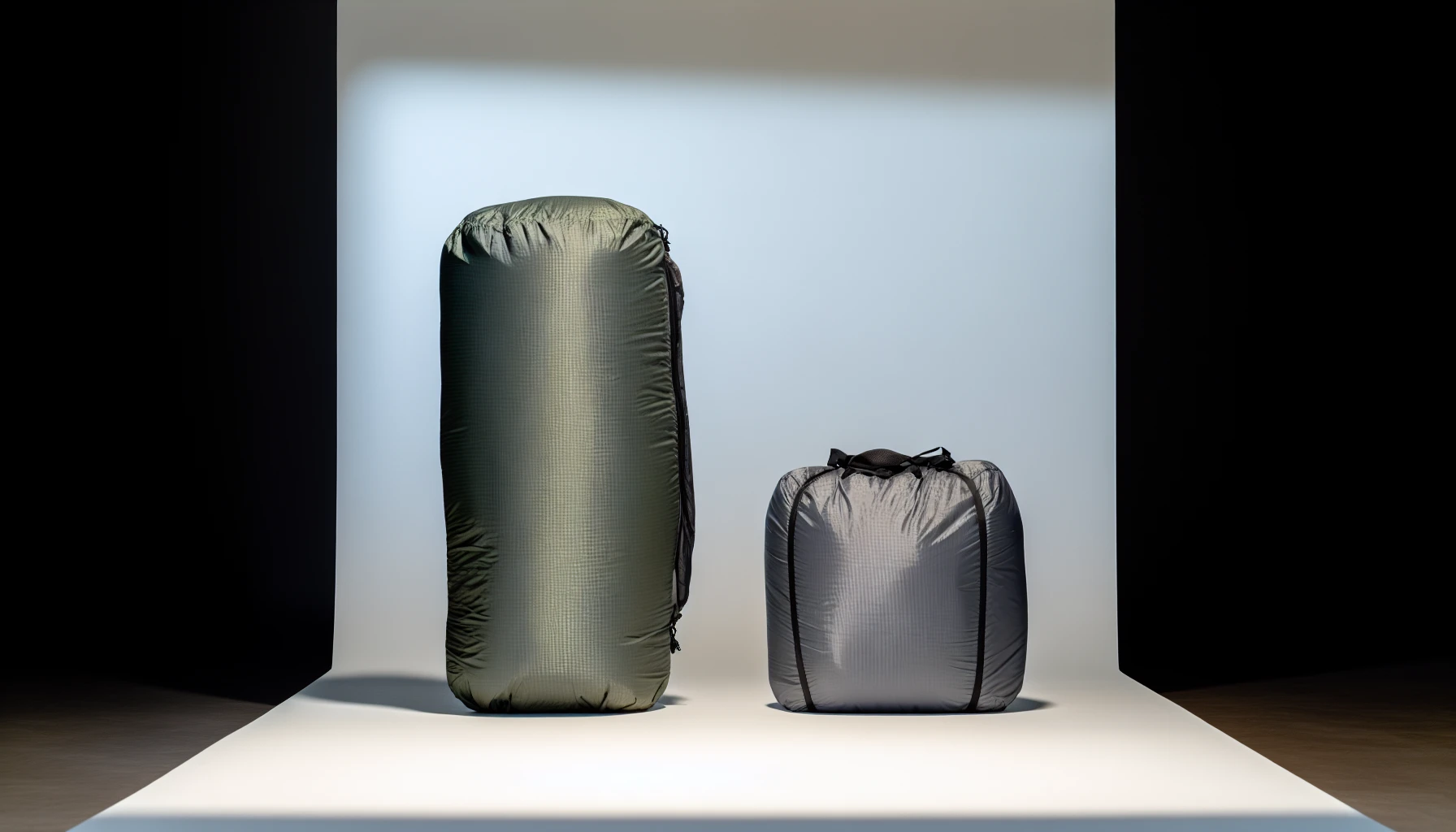
For insulated tents, considerations for weight and packed size will vary based on whether you plan to car camp or backpack. Car camping tents typically prioritize comfort and durability over weight and size, while backpacking tents focus on lightweight and compact design for ease of transport.
Understanding these differences will aid in selecting the best insulated tent for your specific camping situation. Let’s explore the weight and packed size characteristics of car camping and backpacking insulated tents in more detail.
Car Camping: Less Emphasis on Weight and Size
With car camping, your vehicle provides support for heavier and larger tents, allowing you to focus more on comfort and durability rather than weight and size. Car camping insulated tents can be made from thicker and more durable fabric, ensuring they provide ample warmth and protection from the elements.
While these tents may be bulkier and heavier than their backpacking counterparts, the added comfort and durability make them well-suited for car camping adventures where weight and size are less of a concern.
Backpacking: Prioritize Lightweight and Compact Design
Backpacking insulated tents prioritize lightweight and compact design, making them easier to carry on long hikes and treks. These tents often feature double-wall fabric construction, which provides warmth and protection without adding excessive weight. It’s important to strike a balance between weight and insulation when choosing a backpacking tent, as carrying a heavy tent can be a burden during long treks, while a poorly insulated tent can leave you shivering in the cold.
By focusing on lightweight and compact design, you can enjoy a comfortable and cozy shelter during your backpacking adventures without being weighed down.
Insulated Tent Care and Maintenance
Maintaining and caring for your insulated tent properly is key to extending its lifespan and preserving its performance. Regular cleaning, appropriate storage, and prompt repair or replacement of parts will help your tent remain functional and safe for your winter camping adventures.
Let’s explore the best practices for insulated tent care and maintenance, so you can enjoy cozy and comfortable camping trips for years to come.
Cleaning and Storage
To keep your insulated tent in top condition, follow these steps:
- Clean it properly by using mild detergents or specific tech washes. Avoid using harsh chemicals or bleach.
- Clean it with cold water and a non-detergent soap.
- After use, store your insulated tent either loosely packed or hanging. Avoid using waterproof bags that can trap moisture.
By regularly cleaning and properly storing your tent, you can prevent damage and ensure it remains in prime condition for future camping adventures.
Repair and Replacement of Parts
Regularly inspect your insulated tent for signs of wear and tear, and repair or replace parts as needed to ensure its functionality and safety. Common parts that may need repair or replacement include:
- Tent poles
- Zippers
- Fabric
- Seams
By keeping an eye on these critical components and addressing any issues promptly, you can prevent small problems from turning into major issues and ensure your tent continues to provide a warm and cozy shelter during your winter camping trips.
Summary
Insulated tents can transform your winter camping experience, providing warmth and comfort even in the coldest conditions. By understanding the differences between fabric-insulated and quilted-insulated tents, prioritizing key features like ventilation, waterproofing, and durability, and considering factors such as size, weight, and ease of setup, you can find the perfect insulated tent for your needs. With proper care and maintenance, your insulated tent will keep you cozy on countless winter adventures. So, gear up, get out there, and embrace the frosty beauty of winter camping with confidence!
Frequently Asked Questions
Do insulated tents exist?
Yes, insulated tents do exist! Crua Tri is one such example, with built-in insulation to keep you warm in winter and cool in summer. The inside of the insulated storage tent comes standard with a white interior to ensure light. Additionally, fittings can be fastened to the hall's steel frame without any issues.
Can you insulate a tent?
You can insulate your tent by adding foam padding, sleeping mats and thermal blankets - all of which will help keep the warmth inside the tent and create a buffer between you and the cold air.
Can you use an insulated tent in the summer?
Insulated tents can be a great way to stay cool in the summer, as they help keep hot air out and allow for good ventilation. Investing in an insulated tent from a trusted brand like Crua Outdoors is sure to guarantee you a comfortable and cool summer camping experience.
What is the main advantage of a quilted-insulated tent compared to a fabric-insulated tent?
Quilted-insulated tents offer superior warmth and insulation, making them perfect for colder weather camping - giving you the advantage of staying warm in chilly conditions!
Are car camping insulated tents always heavier than backpacking insulated tents?
It's true that car camping insulated tents are typically heavier than backpacking insulated tents, but there are lightweight options suitable for both!

